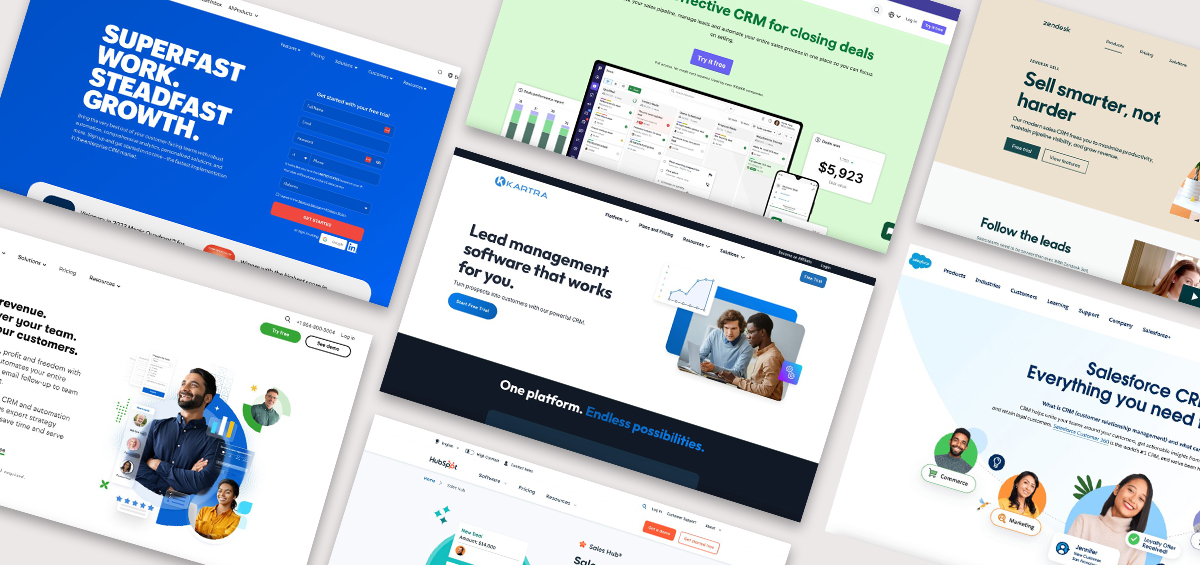There’s only one way to say it: email marketing is critical for digital businesses.
With all the noise online – social media ads, podcasts, websites – it’s tough to stand out. But email can cut through it all. The real-life email marketing examples in this blog will demonstrate why.
The fact is, email packs a major marketing punch. Experts say every $1 you spend on emails generates $36 – $42 back. That’s the best ROI of any marketing channel out there.
But you’ll only see those killer returns if you use email the right way. That’s what this blog post is all about checking out smart email marketing strategies and how to make them work for you. Let’s jump in with the best email marketing examples, so you can start wowing your subscribers and monetizing your list with confidence.
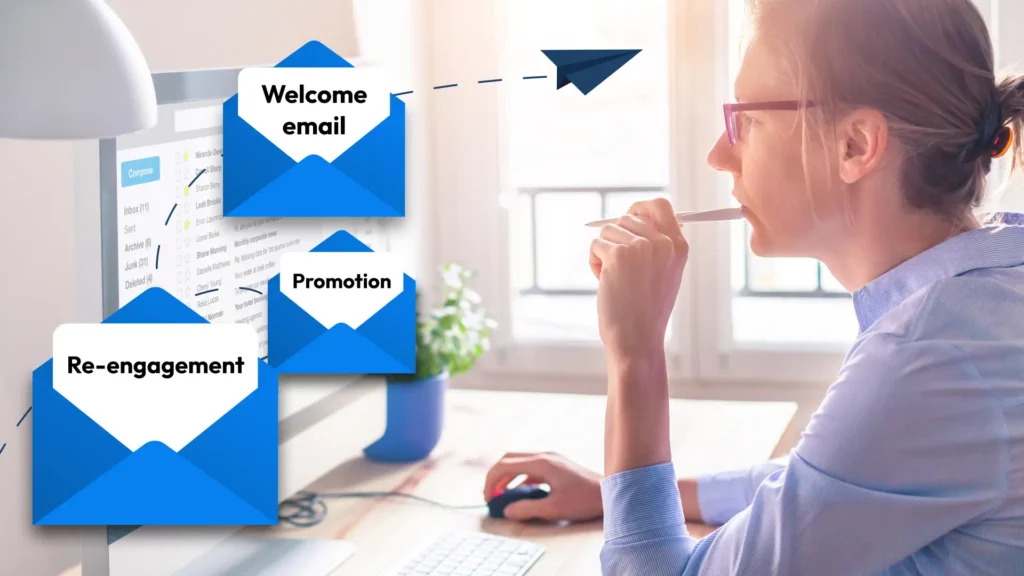
The Best Email Marketing Campaigns to Try
To fully realize the profitability of email marketing, it’s important to send impactful emails consistently – without having to manually send them yourself. That’s where email marketing campaigns come into play.
An email marketing campaign isn’t just an email newsletter. Rather, it’s a series of emails designed to meet some goal, like:
- Welcoming recent subscribers (aka the welcome email sequence)
- Hyping up a product (aka promotional emails)
- Re-engaging folks who haven’t opened your emails in a while (aka re-engagement emails)
- Offering an additional, relevant product to customers (aka upselling emails)
- Informing people about an upcoming webinar (aka webinar emails)
In the online world of business, how well you communicate and connect with your digital customers heavily impacts your growth. This is where email campaigns shine. These types of emails are intended to guide your subscribers on a journey, taking them from curious website visitors to loyal fans and customers.
Building Bonds
Your emails can make your subscribers feel special, especially when you personalize your messages and show that you understand their needs.
Driving Engagement
Through well-crafted campaigns, you can keep engagement up with valuable updates and deals.
Boosting Sales
Of course, email marketing is also a powerful tool to drive sales, but the key is balancing promo content with valuable (and free) info. Now let’s check out some email templates you can use to create your own effective email marketing campaigns.
Email Marketing Campaign Example 1: Welcome Emails
Making a Great First Impression
It’s a great feeling when someone greets you warmly with a smile. That’s the kind of welcoming energy you’ll want to convey in your emails. Make new subscribers feel special instead of just saying a boring “hello.”
These emails are great for lead nurturing, relationship building, and letting your new subscribers know what to expect next. They’re like a digital handshake. It’s the first step to forming a connection with your leads and earning their trust.

Managing Expectations
Let your email subscribers know what they can expect from you when they join your email family. Will you send weekly tips, special offers, or insider secrets? Sharing this information not only prepares them for your emails, but it also helps you figure out the kind of email content you want to create.
This welcome email copy from Food52 says exactly what the subscriber will be getting:
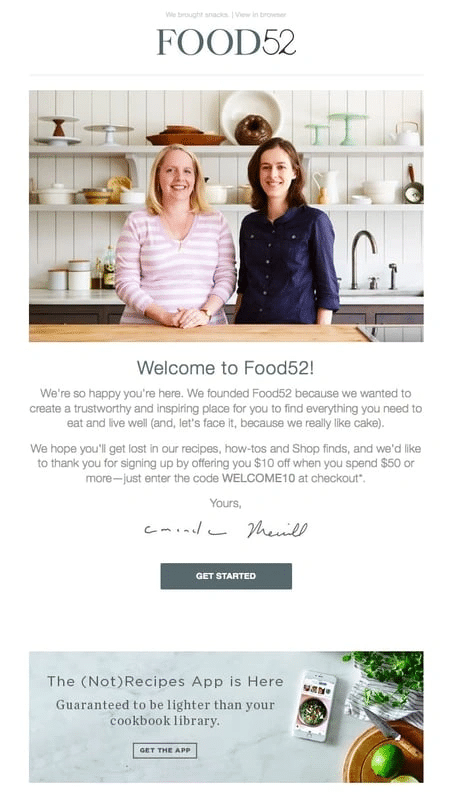
And did you notice that little discount they threw in there? That’s because…
A Small ‘Thank You’ Goes a Long Way
Who doesn’t love a thoughtful gift? Whether it’s a discount code, free eBook, or never before seen content, a little thank you gift can mean a lot.
Here’s another welcome gift email from Kate Spade:
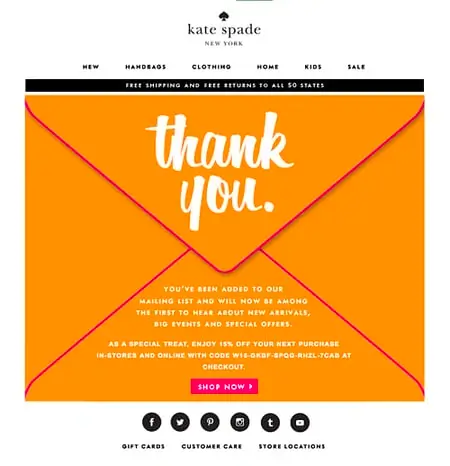
Welcome Email Hall of Famers: Two Approaches to the First Impression
The Storyteller
Picture a welcome email that shares the story of your brand, your journey, or how you created your product or service. Share the human side of your business.
reMarkable went this route:
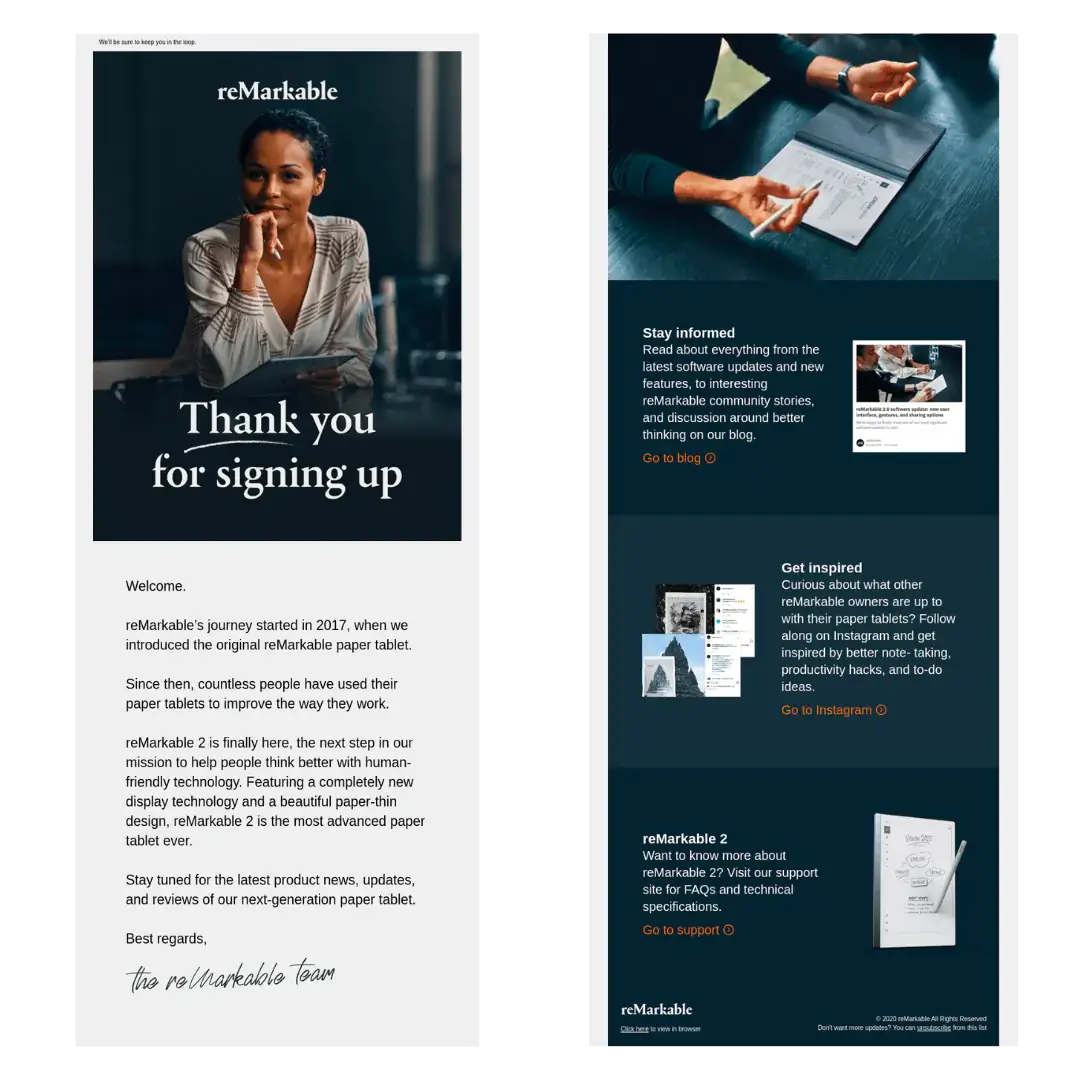
The Guide
You could also guide new subscribers around your site, products, and services. It demonstrates your expertise and willingness to support them.
Omnisend takes this approach with their welcome email:
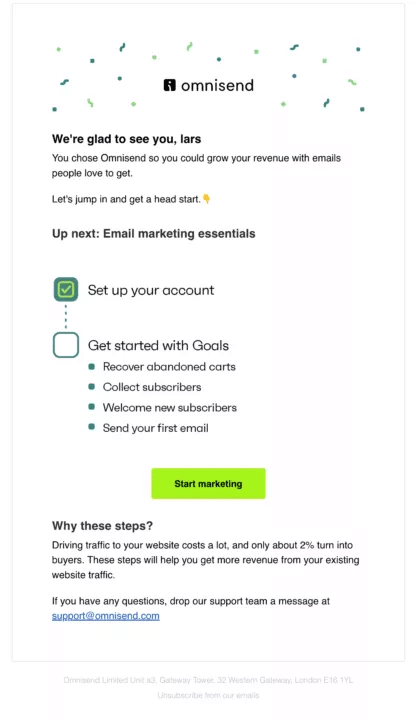
Keep it light. Keep it bright.
The welcome email tone should be positive and cheerful throughout. The email design should also feel light and friendly with readable fonts, like you’re starting an easy conversation with someone new.
The layout should be simple and clean – use headings, bullet points, images, and other design elements to break things up and make it easy to read.
Pipcorn nails it with their welcome email:
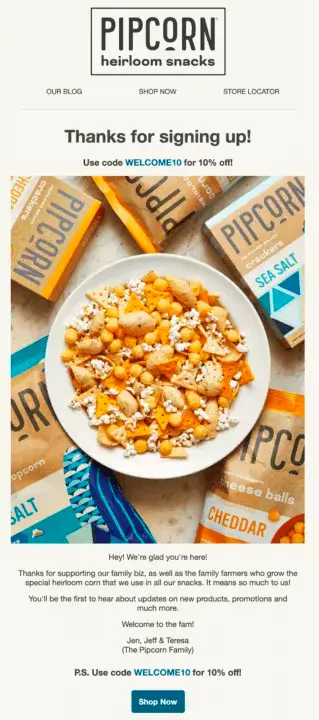
The welcome email is more than an intro.
It sets the stage for what your subscribers can expect from you communication-wise moving forward, so make it genuine and helpful. And be your perfectly branded self! Your genuine personality could turn potential customers into new customers.
After welcoming someone, you’ll eventually want to send promotional content. More on that next.
Email Marketing Campaign Example 2: Promotional Emails
How to Write Promo Emails That Sell and Keep People Reading
Now it’s time to walk the razor’s edge that is the promotional email. These emails can spike your sales, but your subscribers will tune out if you send too many of them. Never fear: there’s a way to find the right balance.
Picture a promo email that doesn’t yell “BUY NOW!” but explains the benefits of a new product or service. After someone reads about all the value they’ll get, they’ll be more interested in buying without feeling like they’re being ‘sold’:
- It’s informative without being pushy.
- It respects readers to make their own choice.
When doing promo emails, focus on adding value and answering for readers “What’s in it for me?” since that’s what they care about most.
The Subtle Art of Promotion

Soft Selling
Think of promotional emails like a friendly suggestion rather than a hard sell. Don’t make this transactional email feel… well… transactional. You want to inform and inspire, not pressure. This makes people trust you more and keeps your brand’s dignity intact.
AllTrails lets the reader know about their new t-shirt line, but they don’t scream at them about it:
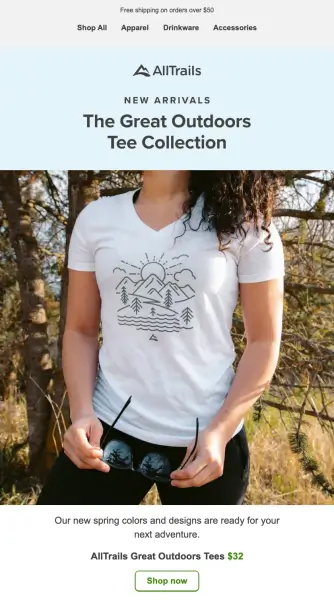
Focus on the Benefits
Highlight what’s in it for the reader. How does your product or service make their life easier, better, or more enjoyable? Answer that, and you’re that much closer to a sale.
Grammarly has a punchy bit of copy – “Win at Writing” – that explains why someone would want to upgrade their free plan:
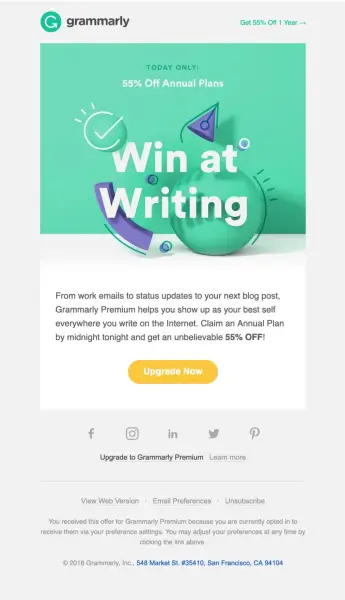
Catchy Subject Line
Your subject line is your first (and sometimes only) chance to grab a person’s attention. Using an email subject line formula can help make your email stand out. Make the subject line intriguing but honest – no clickbait.
Here are some subject lines you can riff on:
- Our Annual Mega Sale Won’t Last!
- Be the First to Explore Our Latest Collection
- Save 20% on Your First Order
- Special Promotion for a Limited Time Only
- Enhance Your [product/service] Experience…
Tell a Story
People love stories. If you can work your promo into a story – like a success story or behind-the-scenes look – you’ll keep people engaged longer.
Casper might be just selling mattresses, but according to their promo email, it sounds like an epic quest for comfort:
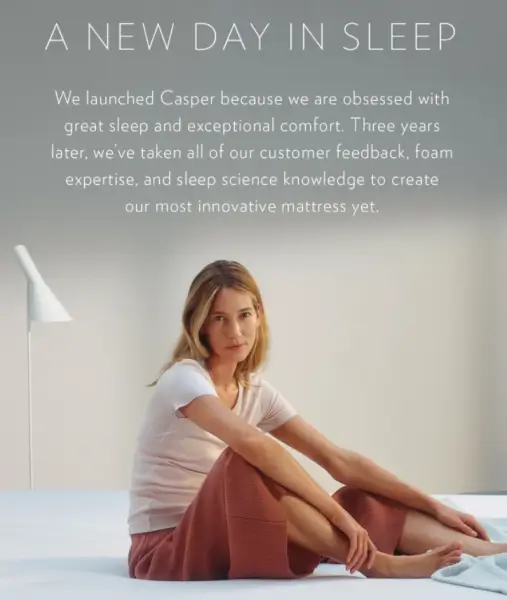
Personalize Your Messages
Send emails about deals and things that match what your subscribers have liked before. Making it about them helps get more people to care and makes the emails seem more useful.
Or if you straight up say “Just for you” like Monki, you might get a strong response:
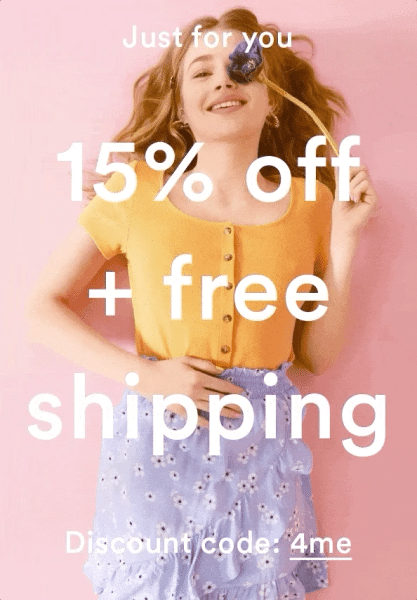
Some Promotional Email Ideas People Like to Read
The Helper Email
Picture an email that talks about a problem a lot of your subscribers probably have, then says how your product or service can solve it. It relates to them and suggests your product’s solution without being too pushy.
Hilton suggests to their subscribers that maybe they want to “relax and recharge” – we all could relate to that:
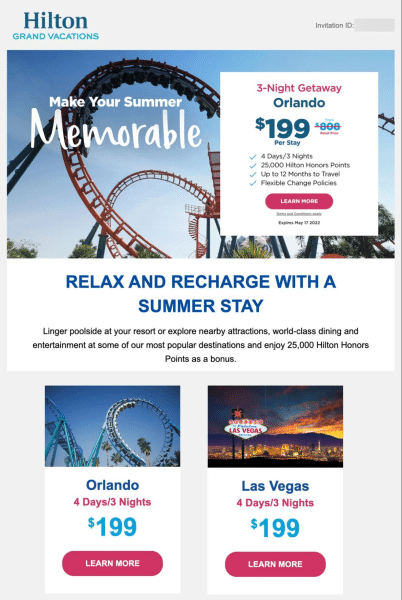
The Special Offer
Try sending an email that gives subscribers early access to some special deal or sneak preview. It doesn’t cost you much except some time, and it makes people feel like VIPs.
Chairish makes a fun, bold announcement about their newest arrivals here:
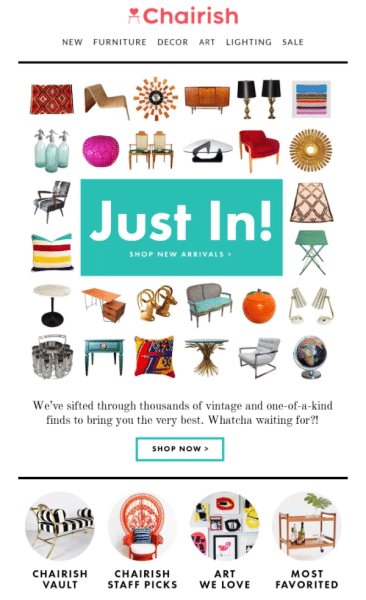
The key to a good promo email strategy is balance.
You want to promote your stuff while still giving value and maintaining a healthy relationship with subscribers. It’s not just about sales and pricing. It’s about experiences that keep people coming back.
Sometimes a special offer or exclusive content can re-spark interest in someone. Check out the next section to learn more about that.
Email Marketing Campaign Example 3: Re-Engagement Campaigns
How to Get Closed Doors to Reopen
Silent subscribers don’t mean they’ve disappeared forever. With the right approach, you can reactivate their interest and engagement! Just be sure that if you’re emailing an ice cold email list, you better warm those people up with serious value to get them to stick around.
Examples of Emails That Get People Back
The Cart Abandonment Reminder
People get busy. Politely remind your online (or eCommerce) customer with a follow-up abandoned cart email that they left something valuable in their online cart without actually buying it.
Whiskey Loot lays out exactly what the person is getting with their service, as well as what they’re missing without it:
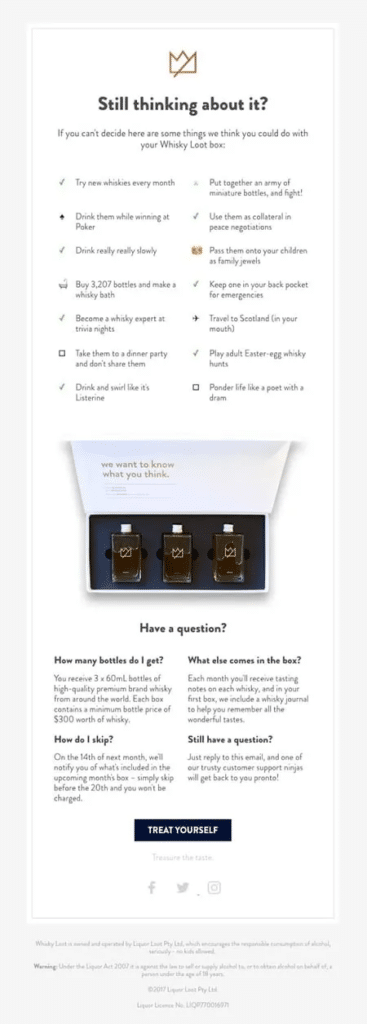
The ‘We Miss You’ Message
Send an email to inactive subscribers saying you noticed they haven’t been around much lately and that you genuinely miss their visits.
Brooklinen uses this exact copy. It also throws in a cute dog, and really, how can you reject a cute dog?
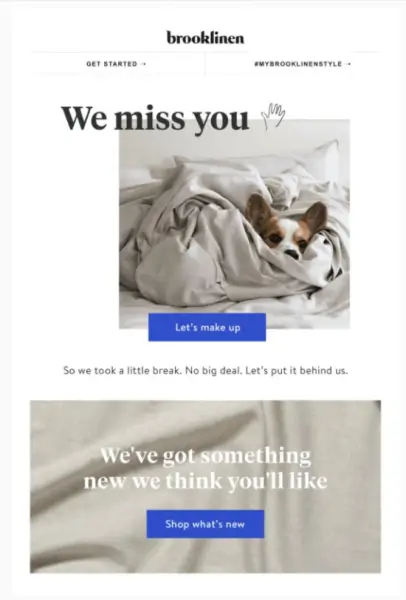
The “How’re We Doing?” Request
Ask what they think. A simple “What can we do better?” shows you care about their opinion.
Nordstrom Rack makes it very clear that they want the person’s opinion:
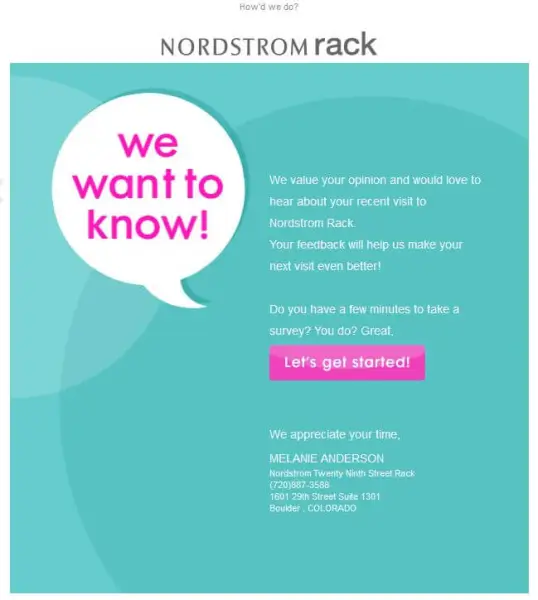
Keeping it Positive
Avoid Sounding Pushy
The tone should be friendly, not desperate or demanding. Think of it as a nudge, not a plea, for reopening communications.
Lowe’s adds a little intrigue (and on-brand wordplay!) to their re-engagement email:
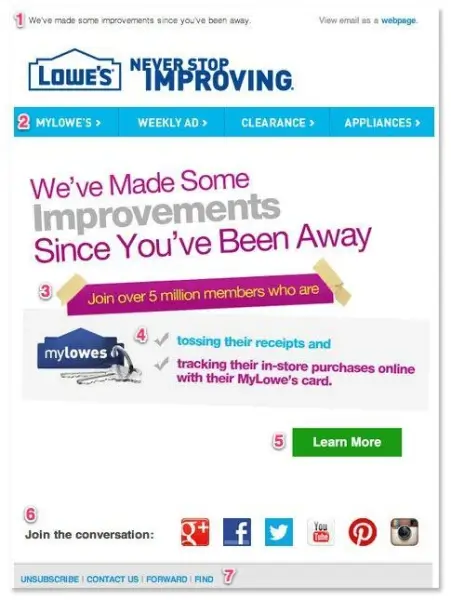
Make Unsubscribing Simple
It may seem wrong, but making it easy for people to unsubscribe can actually make more people stay signed up long term and improve your email deliverability. It ensures people who opt-in are truly interested in what you offer.
Animoto sends out an email asking inactive subscribers if they want to stick around:
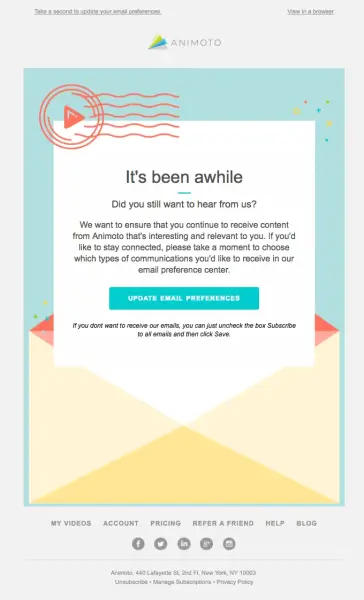
Re-Engagement as a Learning Opportunity
Reconnection campaigns let you reconnect while also learning. They offer insights into what works, what doesn’t, and how you can improve your overall email strategy.
Don’t fear someone tuning out for a while. Embrace them, understand them, and welcome them back with open arms if they return. After all, everyone loves a good comeback.
Email Marketing Campaign Example 4: Email Upsells
Getting More Money Ethically from Customers
Your customer has already bought something from you. Now it’s time to see if they’d like to buy something else that would be a great fit for them.
Emailing customers to get them to buy more stuff is like offering dessert after a great dinner – it improves the experience and it’s pretty darn sweet. If done correctly, it brings in more money and also adds value to your customers’ lives.
The Skill of Upselling without Being Obnoxious
Subtlety is Best
Upselling is when you invite a customer to purchase something additional or more expensive. The main thing for successful upselling is to be subtle. Your emails should seem like you’re helping the person make an informed decision, not pushing them to spend more money.
Medium accomplishes this tone well:
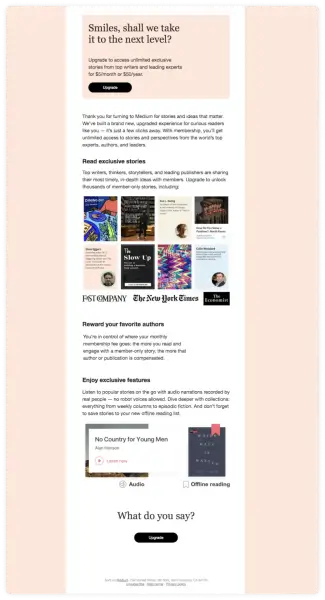
Connect to What the Customer Needs
Make sure your upsell relates to what they’ve already bought or shown interest in. It’s all about improving their experience with products or services that actually add value.
AllTrails has email subscribers that want to explore the outdoors. So they started their email with “Your next adventure is closer than you think” and then explained all the additional features they include on their Pro plan. Their subscribers are already using AllTrails for exploring – maybe they want to keep exploring with these added features.

Add a Personal Touch
Start by recognizing their previous purchase or interaction. A simple “We hope you’re enjoying [product/service]” sets a positive tone.
Grammarly does a year-end recap for each unique subscriber to see how much they used the software. Then it highlights all the writing mistakes they missed by not having a premium account:

Highlight the Perks
Explain how the upsell complements or improves the product they already have. It’s not about the actual product itself, but the value it provides them.
Framer shows how limited their free plan is compared to the Pro plan. After seeing this, wouldn’t you consider upgrading?
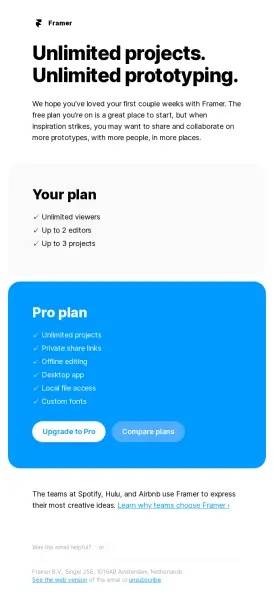
Create a Sense of Urgency
Limited-time deals or exclusive offers can get people to act without feeling forced.
Wix sent out a limited time 50% off sale email. The irresistible discount plus the fact it will go away makes it very tempting for people to consider:
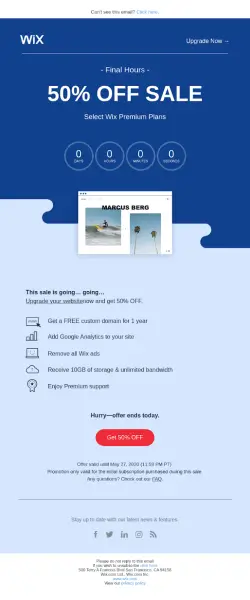
Real Examples of Upsell Victory
The Perfect Pairing
Picture an email suggesting a product that flawlessly complements what the customer just purchased. For example, you could offer a one-on-one consultation call for a customer who bought your online course.
Or for Dollar Shave Club, you could offer more add-ons to ship out with the customer’s order:
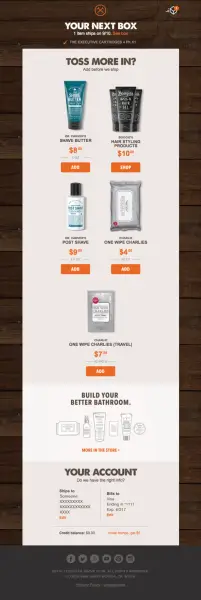
The Upgrade Proposition
This email offers folks an upgrade to a fancier version of a service they already like. It’s like an exclusive invitation to get more out of something that makes them happy.
Tinder explains all the fanciness their Gold status provides in this email:
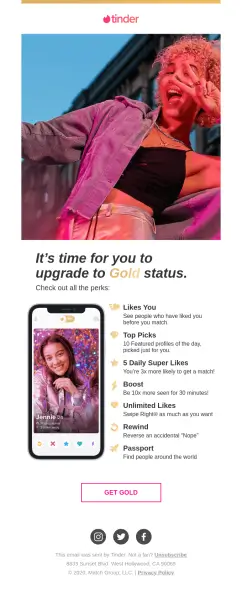
The Upsell Strategy That Boosts Your Sales
Know Your Stuff
To upsell well, you have to understand your products and how they connect. Map out that web of products you have and see where the strongest connections are.
Listen to Customers
Pay attention to what customers say and what they buy. It’ll give you ideas about what they might want to buy next.
Switch it Up
Try different upsell approaches and see what works. What flies with one target audience might flop with another.
Upselling as a Growth Tactic
Upselling through email isn’t just about getting bigger orders. It’s about giving customers extra value. When you keep the customer in mind, it strengthens your relationship and makes their experience with your brand better (and that extra revenue isn’t too bad, either).
Email Marketing Campaign Example 5: Webinar Emails
A Power Combo
Now we get to the combined forces of email marketing and webinars. Together, they can seriously engage your audience and boost brand awareness. Webinars offer useful takeaways, and email is the perfect way to hype them as “must attend” events.
Spreading the Webinar Word via Email
Building Excitement
Email is awesome for getting people pumped about your upcoming webinar. Send out those VIP invites and see the registrations rise.
Miro includes their impressive list of speakers in this email:
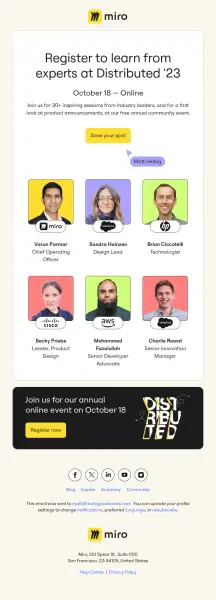
Staying in Touch
One email rarely does the trick. Sending reminder emails leading up to the date gets way more people to attend.
Kiwi Wealth sends a reminder email the day before:

Make the Webinar Pitch Irresistible
Why MUST they attend?
Is there special info they can’t get anywhere else? Cutting edge ideas to learn? Things that help them use your product better? Make your webinar sound impossible to miss.
Fender Play highlights their live programming schedule, which people would miss if they weren’t members:

Include the Details
Pretty important thing to include: say when the webinar is! Date, time, and time zone are a great start. You don’t want people to miss it or tune in at the wrong time. Be sure to explain how to sign up as clearly and simply as you can.
The Conference includes the details clearly and also how to access it easily in Arabic:
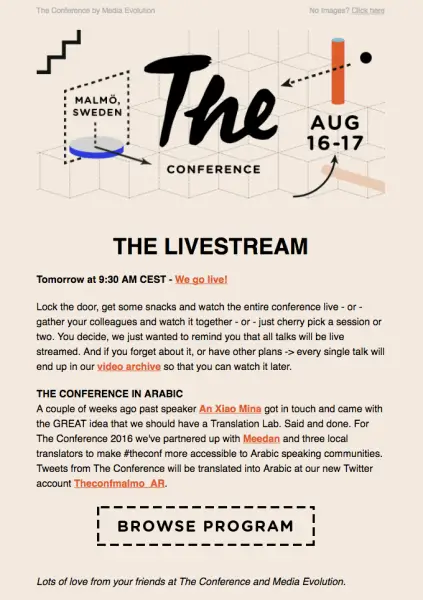
Tell a Good Story
This helps people imagine the transformation they might get from attending. You could share a real case study from one of your customers or include compelling statistics about your topic.
Codeverse puts the subscriber as the hero of the story with the question, “Will your kid bring home the trophy?!” Now what parent wouldn’t respond to a question like that?

Some Email Ideas That Pull in More People
Have experts give snackable bits of advice leading up to the day.
This gives your event credibility, and that’s a great thing.
Or for an evergreen webinar, you can be like Impossible Foods and explain the experts involved in their discussion about plant-based eating:
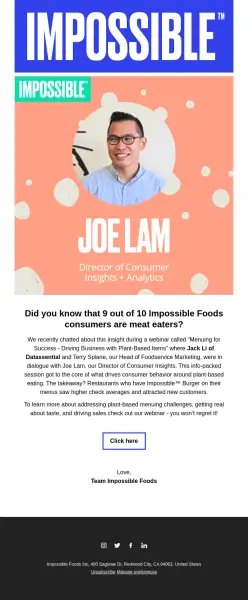
Do an email countdown to the day
A countdown keeps your webinar in people’s minds and gives them some urgency to attend.
This webinar registration email includes a countdown clock, but it goes one step further. If you look at the fine print, it says there is only space for 100 registrants. So it’s a double countdown: they only have a day left to register, and they might not snag a spot!
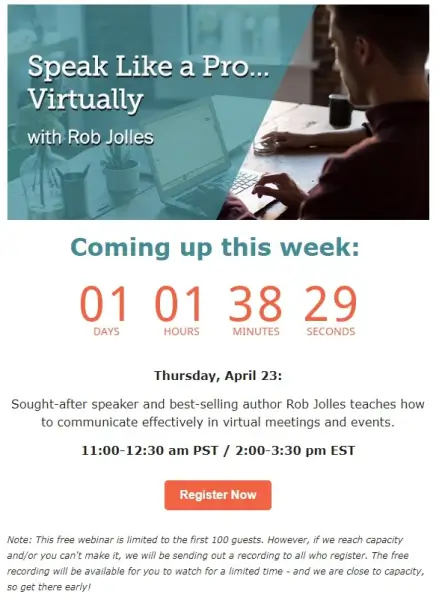
Once it’s over, you can still connect!
Thank everybody for attending in a nice email.
Include a link to watch the recording if they missed it or just to rewatch the juiciest parts. Give more valuable info the talk didn’t cover or survey folks asking what they thought.
Wistia sends out a recap email after their digital conference:
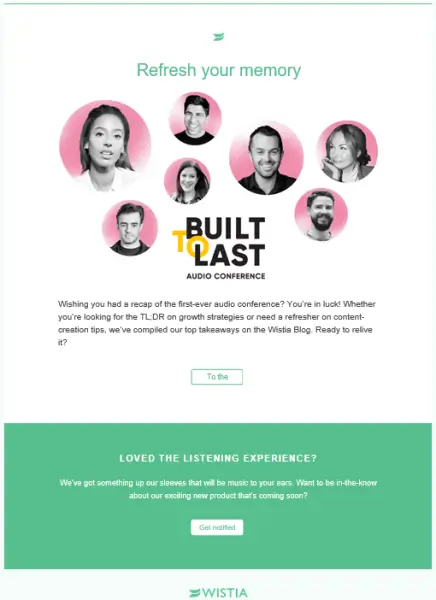
Keep that ball rolling.
Tell your attendees about other content or products you offer that relate to your webinar topic.
Chase Center isn’t a webinar platform – it’s a live event space. But they use this tactic that you can apply post-webinar to suggest future experiences your subscribers might enjoy:
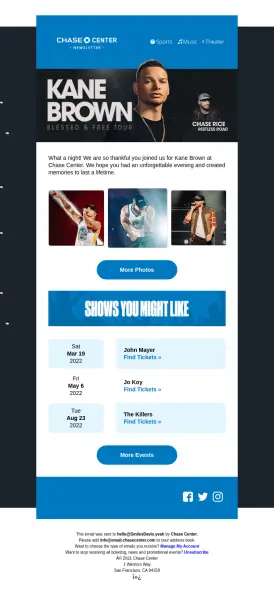
Like Coffee with a Sunrise
Pairing webinars and emails can yield some amazing outcomes and they complement one another with their personable communication approach, engagement potential, and value. With strategic emails, webinars extend their reach and resonate with more folks. Everyone wins!
The Ingredients for a Successful Email Marketing Campaign
We just looked at some types of successful email campaigns. Even though they seem different, they’ve actually got a lot in common if you step back and look at them holistically.
Let’s break down what makes any email campaign work.
Clear Goals
Every good campaign starts by defining what it wants to achieve – maybe get more sales, drive traffic to a website, or get more people to a webinar. And having a clear CTA button (call to action) in the email will help explain your goal to your subscribers, too.
The journey can be the destination when you’re backpacking through Europe, but knowing the end goal of an email campaign is critical.
Content That Draws People In
The emails themselves need to grab attention and keep readers hooked. That might mean an interesting story and eye-catching images or an offer that’s impossible to resist. Whatever it is, the content should engage readers and relate to them.
Personalization: No More One-Size-Fits-All
Generic emails that could be sent to anyone are outdated. Modern campaigns have personalized emails that use the reader’s name, past interactions with the brand, and specific interests.
Trust and Honesty
Brands have to communicate openly and transparently to build trust. Once that’s lost, trust is tough to regain in the email marketing game. Always keep your honesty cranked to 100.

Measuring Success: Look Beyond Open Rates
Studying the Right Stats
While open and click-through-rates matter, go deeper. Do the emails improve conversion rates and help accomplish your campaign goals? Vanity metrics don’t help your bottom line. You can always use A/B testing to help optimize your results.
Listen to Feedback
Surveys and responses provide invaluable input on what works and what doesn’t. As you get more confident with your copywriting and understand email marketing better, try expanding your campaigns. Mess around with different types of content marketing, segmentation, and personalization.
You’re Always Learning
Email marketing moves fast. New trends pop up all the time. Keep educating yourself. Stay current, and don’t be scared to attempt new tactics.
Celebrate the W’s. Learn from the L’s.
Every email campaign, win or lose, teaches you something. When one works, take note of why. When one flops? Now you know what to tweak for next time.
Parting Words: Your Journey to Email Dominance
Remember that mastering email marketing is a personal path that hits roadblocks but also lets you connect with people in a very personal way. Be patient, persistent, and always keep your audience in mind when crafting messages.
You have the knowledge, email marketing tools, and motivation. Now go out there and transform good emails into great emails. We look forward to seeing your incredible campaigns hit our inboxes soon.
If you’re ready to dive deeper into email marketing, you can learn how to use email marketing automation to catapult growth here. Automated emails make life a whole lot easier once you know how to create them.
About Kartra
This blog is brought to you by Kartra, the all-in-one online business platform that gives you every essential marketing and sales tool you need to grow your business profitably – from sales pages and product carts to membership sites, help desks, affiliate management and more. To learn how you can quickly and easily leverage Kartra to boost your bottom-line, please visit kartra.com.

